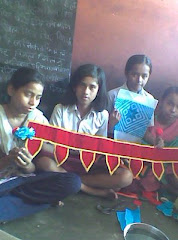
What does this old skeletal of a building mean to me? Though its essential character has been ripped out, the place holds for me some of the most pleasant memories of a childhood. Of fun and games, care and friendship and discovery of the essence of India.
It was my grandmother's home and I visited it regularly ...almost every fortnight, sometimes staying over during vacations. It stands on one of the most bustling streets of Old Delhi called Chandani Chowk.
Once it was filled with people, relatives and friends, old and young. Sounds of laughter would reverberate through it; an aroma of delicious food would hang over it. It would sit in so well in the cacophony of life in that busy history-rich street. My grandmother, Bibiji, ruled over it like a true matriarch. Its main door was always open. Anyone was free to go up, and many did; members of the extended family, neighbours, beggars who needed alms, the local politicians collecting funds. Everyone was welcome. And people would flock to meet that one woman who gave the building such life and vibrancy. The building lost it all with her death. I couldn't get myself to visit it for decades.
Recently, a relative came visiting from London and I took him to discover Old Delhi. We had to pass the house and what I saw.....it had changed beyond recognition. Its character had gone, it had been peeled away. It seemed as if the owner was going to give it a brand new look. Iron girders had been installed. The lovely green painted iron pillars were no more and railing of the balconies that ran along its length, could only be seen in parts. If you click on the photo you can see portions of the beautiful railing, in the building which was built about 200 years ago.
My grandmother had rented the first, second and third floors of this building in 1947, soon after the Partition of India into India and Pakistan. The family was fleeing from Lahore, the city that had been home for generations. My mother, who was in her teens, narrates how war cries between the Hindus and Muslims would rent the air and they would see Hindu houses being set on fire. Some women she knew had been kidnapped and raped by the Muslims. She would blame it on the power hungry political leaders who had betrayed their people, ruined the perfect camaraderie between two communities that had together fought for freedom from the British. My grandparents being Hindus decided it was best that they leave Muslim dominated Lahore, which had become part of Pakistan, and set up home in Delhi. So one terrible day as blood cries rented the air, my grandmother left with a band of six children and some members of the extended family for Delhi. My grandfather stayed on behind to wind up the business and died a year later.
Grandmother's first task on landing in Delhi was to find a place to stay. Her eldest son located the building, we were told. I think the fact that it housed two chemist shops on the ground floor attracted the family to it. My grandfather ran a chemist shop in Lahore - Beli Ram and Sons. It was one of the biggest and the best known.
It was from this building that I discovered the rich secular fabric of India. On this road stand Gurdwara Sis Ganj Sahib (a Sikh worshipping house), the Gauri Shankar mandir (a Hindu temple), the Sri Digamber Jain mandir (a Jain temple) and the Sunheri masjid (the Muslim prayer house). On the opposite side is a little church said to be the oldest Baptist Christian church in northern India.
My grandmother would sit on a charpoy pulled out into the balcony and I would stand, my head a little higher than the railing, as she would point out the sights. We would watch the religious processions pass below and she would tell me what they signified. This little street showed that different religions can cohabit, as long as each respects the other. And like monocultures which harm the earth, mono-religions, weaken the secular fabric of a nation. India gives people the right to pray, to worship any way they want, any God they may chose. Indians respect different religions, and participate in each others festivals. You may choose to question aspects of your religion or you may faithfully follow; the choice is yours. That is the essence of India that I grew up with. I marvel to this day that my grandmother bore no grudges. She would welcome with open arms any friends from Pakistan who came over.
While four of my cousins who lived in the house, studied in a convent school, one of them went to an adjoining school for girls run by the Jain nuns. The blue board in the photo announces the school. If you click on the photo you can read its name. So great was the influence of this school on her, that she grew up to be a pure vegetarian in a meat-eating family.
Bibiji kept an open house. Family and friends could drop in any time and be treated to a hot meal. Many women, pushed out by their families, sought refuge with her. A bed would be provided and the person could stay as long as he or she wanted. Some would spend a day pouring their heart out to her, complaining about abusive husbands and sons, while others would come to recuperate from an illness or seek her guidance on relationship and matrimonial matters.
She would sit crosslegged on her charpoy, dressed in white, her snow white hair pulled into a neat bun. Three other charpoys occupied the room and each had its respective corner. A visiting daughter and her children, or an abandoned woman seeking refuge would occupy the other charpoys.
On one corner of the room were her Gods. It was in her that I discovered my first feminist. At a time when it was taboo to touch the gods or visit the temple if you were having periods, she refused to toe the beliefs blindly. If God thinks women pollute he would not have made them, she would tell us.
While the first floor served as an office for my uncle, the second floor were the living quarters - housing two bedrooms and a store. The third floor had the kitchen, the servant's room, a spare room used to store the many charpoys and bed rolls ready to be rolled out for guests as they came in. Sleeping on the terrace on crisp white linen under the star-spangled sky exhanging ghost stories with cousins is an experience I have never been able to duplicate.
The rooms in the two-century-old building were divided by wooden planks burnished a rich brown. The floor was of uneven kotah stone blocks joined together by cement. For the children it was a readymade hopscotch floor and we used it to our advantage. The high ceilings kept the place cool in summer. The house had no wardrobes. Clothes, bedding, linen would be kept in big steel trunks. One piled on top of the other in the second-floor store. A small steel almirah housed my grandmother's most prized possession -- a range of the yummiest pickles made by her. We were forbidden to touch it. She didn't want our dirty hands diving into the stone jars to sample the aromatic stuff. Instead, each day she would dish out a small amount into a porcelain cup for consumption. When she was not looking the cousins would sneak into the room, but the almirah made such a clatter while opening that she would get alerted and we would receive a dressing down.
Even the birds and animals felt at home in this house. A flock of pigeons would live on the ledges around the building. One or two brave birds would venture in to occupy the wooden ledge in her room. The neighbourhood cats would walk in and out with impunity. Saucers of milk would be placed for them at one end of the long balcony, while the pigeons got fistfuls of grain every morning from her. It was here that I saw a cat hunt a pigeon. And one dark stormy night encountered two gleamy green eyes next to my bed and let out a scream that shook the whole household upright and they came running to find out what had happened. But Bibiji, on her charpoy opposite mine, just turned over her side and told me, '"Go back to sleep, it is just the black cat. You have scared her away."
She was the ever indulgent grandmother. She knew the favourite foods of each of her grandchildren, and as and when he or she arrived, a servant would be dispatched to bring the goodies. It was here that I dug my teeth into the valewale samose, gorged on the juicy fruit chat, was introduced to chilled rabri and rose-flavoured and kesar-badam kulfi. The famous sweet shop - Ghantewala is right opposite this building. and when we left for home, she would get a box of the most delicious Indian sweets packed for us as a parting gift.
It was at her place that I ate the best cooked mutton ever. And the sumptuous tandoori chicken. Though she rarely stepped out of her house, she knew where the best was available.
It was from here, that I discovered the richness of the Indian arts. At Dariba - the lane that houses the gold and silver jewellery shops - my mother traded her old jewels for new ones and bought my sister and me our first set of gold earrings. We would walk the Kinari bazar looking for intricate borders and sequins to attach to dupattas. It was in one of the gullies (narrow lanes) that I discovered a nondescript bangle shop which had the most exciting bangles I have seen. I flaunted them in college and the girls hounded me to know where I got them from.
It is here that I got introduced to Bollywood. My parents were no movie buffs, but my unmarried aunt would aim to catch the first show of each movie as it was released. And if I happened to be in Chandni Chowk on a Friday, I would get to see it with her. There were a choice of film theatres. A couple survive to this day.
Chandni Chowk, translates into a moonlit square. It is said a canal once ran down the entire length of the street with Red Fort on one end and Fatehpuri masjid on the other. History tells us that the Mughal king, Shah Jehan's daughter, Jahanara, took an active interest in the landscaping of the area. She had a market set around a square pool and on moonlit nights the waters turned a magical silver and hence the place got its name. The canal was gone much before my grandmother set up her house here...
I head for the main door of the building, hoping to run up the steep staircase, like I did as a teenager. A panwala sits on the platform in front of it, like his father had done decades ago. Only the man does not know who I am. His father would greet me with a 'namste beti' (greeting to you daughter) and put a cardamom and some meethi supari (sweetened betel nut) into my open palm. The double panelled door is bolted. A big lock hangs from the latch. In this age of terrorism, you cannot keep open the door of even a bare building. Time changes...but I feverently hope the essence of India would live forever.
.jpg)





+(2).jpg)


6 comments:
Beautiful. Read without stopping from beginning to end.
You say so much in this post ... hats off to your Bibiji... her home sounds like a warm, loving haven, so does her attitude.
Thank you. Yes, Bibiji, was one truly remarkable woman.
Very refreshing nostalgic account Shree. I completely agree with you on the prayer for the "essence of India...." Actually in its own subtle way the essence of India remains, right ? - in its people / varied cultures/ and in so many minute details - like the distinct fragrance of Madurai Gundu Malligai !! - the unique lovely jasmine from the southern city Madurai.....
The narration is so lucid and lively :-) I can actually hear your vibrant voice narrating the story.
Aruna! The jasmine... beautiful heavenly flowers..take you straight to the south...
but the fragrance is so essentially India...like you say. Glad you like the piece.
I think it's not enough to say Beautiful! I was totally IN this post. I had "chicken skin" all the time I was reading... I could feel your nostalgia deep in my heart... And the way you are writing! Wonderful! I will be on your blog from now on that is for sure!
memories always alive
Post a Comment